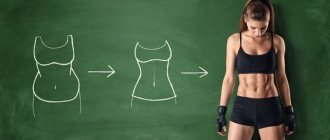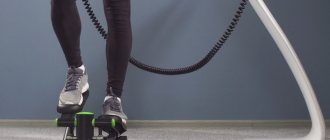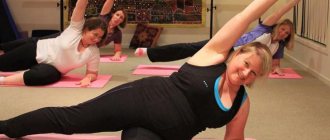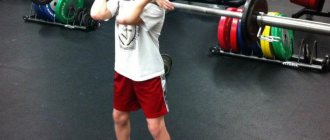In our dynamically developing world, every hour is of great value. Few people can afford to devote time to regular exercise. Achieving good results in a short period is a dream that can come true.
Spend just one hour a week on sports and stay in excellent physical shape, burn fat and build muscle in 15 minutes of exercise - all this is a HIIT training system. She has managed to establish herself all over the world. Let's take a look at what this unique direction means.
What it is
HIIT training is high-intensity interval training, a mix of aerobic and anaerobic exercise, alternating cardiorespiratory and strength exercises of varying degrees of intensity. The essence of the training is to “start and pump up” metabolic processes in the body, increase the endurance of the heart and muscles, and accelerate fat burning. Among other advantages of the direction, experts note three main advantages of HIIT:
- Training time is only 15 minutes 3 times a week. This is a convenient option if you don’t have free time to maintain good physical shape.
- HIIT helps prepare the body for a hike in the mountains or a cycling marathon and increases endurance significantly.
- Training allows you to achieve noticeable results in losing weight in a short period of time.
Scientific background
In a professional sports environment, interval training has long established itself as a quick and safe method to get the body into the desired shape. Coaches use this kind of “buildup” to prepare the athlete for competitions, after which they return to the normal pace of training. The essence of the method is that training using the HIIT system increases the frequency of contraction of the heart muscle to 80% of the maximum, taking the body out of its stable comfort zone for a few seconds. As a result, endurance increases significantly.
Research on the effects of HIIT on humans has been conducted all over the world: in Japan, the USA, Great Britain, Brazil, and Russia. Both athletes and untrained people leading a passive lifestyle took part in the experiment. Scientists have confirmed that short interval training allows you to burn 6 times more calories and body fat than regular fitness classes at a steady pace. The result of the research was the adaptive HIIT program.
HIIT strengthens the cardiovascular system
Scientist Butcher provided a comprehensive review in 2011, reporting that HIIT can improve cardiorespiratory function (VO2max) by 4 to 46% in healthy young and adult men and women over 2 to 15 weeks of training. Scientist Kessler and colleagues also say that HIIT causes dramatic changes in VO2max.
The increase in VO2max resulting from HIIT-style training is believed to be associated with a subsequent increase in cardiac stroke volume (the volume of blood pumped per heart beat), which in turn is caused by an increase in the contractility of the heart muscle during near-maximal exertion.
To summarize, Butcher also notes that HIIT is associated with an increase in mitochondrial biogenesis (an increase in the size and number of ATP factories - mitochondria), which leads to improved cardiovascular function at any level of training intensity .
In terms of health promotion, an increase in VO2max is quite significant, since low levels of cardiorespiratory function are associated with an increased chance of dying from cardiovascular and other diseases (Kessler et al., 2012).
In simple terms, as VO2max increases, the chance of dying from cardiovascular disease decreases..
In 1996, scientists from the Cooper Institute conducted a very valuable study on the benefits of cardiorespiratory training. During the study, specialists conducted medical examinations and tested VO2max in 25,341 men and 7,080 women.
The data from that study clearly showed that regardless of whether the subjects were healthy or unhealthy, smoked or not smoked, had normal or high cholesterol, were overweight or not, those who were more physically fit were less likely to get sick with cardiovascular diseases .
Additionally, in 2006, scientists Swain and Franklin reviewed epidemiological and clinical studies that looked at the effects of low- and higher-intensity exercise. All of these studies showed very similar results - higher intensity training had greater benefits in terms of positive effects on one or more risk factors for coronary heart disease.
Thus, to combat cardiovascular disease, the No. 1 cause of death in the world (according to WHO in 2013), HIIT should be considered the most beneficial training method.
What are the benefits of interval training?
HIIT is among the TOP fitness trends in 2022 and 2022. Thanks to this method, the fat burning process continues even after the end of the lesson for a period of 5 to 24 hours. The American College of Sports Medicine (ACSM) has concluded that metabolic acceleration occurs after the end of training, and the effect continues to grow with each subsequent session.
For those who have lost weight using a calorie counting system at least once in their life, the principle of the “swing” is well known, when the body adapts to a decrease in kcal consumption and the weight stops moving down. In this case, it is recommended to alternate between fasting and overeating. HIIT works the same way. Interval training helps:
- quickly “dry” the body, replace fat deposits with muscle mass;
- improve the body’s energy reserves several times;
- increase endurance and strength;
- maintain normal weight, even with increased calorie intake;
- strengthen the heart muscle;
- reduce cholesterol and sugar;
- improve immunity, eliminate the development of ischemia and type 2 diabetes;
- get rid of overwork and depression;
- increase testosterone and growth hormone.
Harm and contraindications
It is believed that HIIT classes are not suitable for beginners, and to switch to interval training, certain physical preparation is required. This statement is not entirely true. Extreme sports training is suitable for everyone who is relatively healthy, but before starting classes you must undergo a medical examination and tests. Absolute contraindications to HIIT:
- diseases of the heart and blood vessels;
- suffered a stroke or heart attack;
- diagnosed type 1 diabetes;
- long-term smoking and alcohol consumption.
In other cases, the type and intensity of exercise depends on the initial physical condition of the person. Provided you have a reasonable approach, HIIT training is acceptable even in the treatment of obesity. The main thing is to constantly monitor your heart rate using a fitness bracelet or heart rate monitor during exercise.
The effect of interval training on the body dictates certain restrictions in diet and lifestyle:
- It is recommended to refrain from taking fat burners, caffeine, stimulants or cardiovascular drugs before training;
- You should not drink drinks containing fast carbohydrates and sugar;
- You should not visit the sauna after class (a cold shower or swimming pool is better for relaxation);
- It is forbidden to combine hiit and a carbohydrate-free diet (this can lead to a sharp drop in blood sugar levels and fainting).
Beginners should only exercise under the guidance of a trainer, who will help develop a detailed training plan with a gradual increase in time and intensity of stress on the joints and nutrition recommendations. Most video lessons describing the regime are designed for physically fit and absolutely healthy people.
The first workouts should take no more than 5-15 minutes. You can set aside about an hour a day two or three times a week and this is enough to change clothes, take a shower and have time for a restorative massage session or have a snack at a healthy food cafe, for example, at the LaSalute club. After a high-intensity workout, many people notice a strong appetite.
Alarming symptoms after HIIT that you should immediately pay attention to: a constant feeling of fatigue, acute muscle pain and shortness of breath. This condition is a reason to stop training and immediately consult a doctor.
Effect of HIIT on cholesterol levels
Kessler analyzed data from 14 studies that looked at how HIIT affected changes in cholesterol levels. Research data suggests that this training method has a positive effect on high-density lipoprotein ("good" cholesterol) levels after a minimum of 8 weeks of training.
Scientists also suggest that HIIT, along with concomitant loss of fat mass (or total body weight), may improve blood levels of total cholesterol, low-density lipoprotein, and triglycerides.
Types of HIIT
The training program for an ordinary person is almost always built individually. According to the HIIT method, it doesn’t really matter what you do: jump rope, use an exercise bike, run in the park or on the track in the gym. The main thing is to alternate active efforts at the limit of your capabilities with periods of rest, carefully monitoring your pulse. In one five-minute session it is permissible to combine various types of interval training: cardio and strength training, running and jumping, stretching and squats with weights.
Tabata Protocol
This type of interval training has a clear timing: 20 seconds of maximum load alternated with a 10-second rest. One approach or circle takes 4 minutes, during which you need to perform 8 sets of any exercise: push-ups, pull-ups, squats, etc. A warm-up is mandatory to warm up and prepare the muscles.
Gerschler method
The effectiveness of interval training is determined by your heart rate. The heart rate accelerates to 80-85% of the maximum, and then 2 minutes are given to rest, during which the heart rate should recover to 120 beats in 60 seconds. The sets continue until the heart rate stops falling during rest. This is a signal to stop training. On average, the duration of a lesson is 20-30 minutes.
Fartlek
Group interval sprint based on competition using a standardized protocol:
- 10 minutes warm-up, jogging;
- 10 minutes of running at high speed;
- 5 minutes of brisk walking to relax;
- 100 m straight, race;
- 100 m race on a slope, uphill;
- A 5-minute cool-down walk takes the body out of stress.
Exercise bike
This type of HIIT involves:
- 5 minutes of warm-up in a calm mode;
- 30 seconds – maximum speed at high resistance;
- 1 minute – rest at a medium or slow pace with minimal resistance.
Beginners should not choose complex sets of exercises. This will not be of particular benefit, since the body needs time to adapt to the stress. For the first month, running, swimming, jumping rope, cycling or orbitrek are suitable. Then classes can be diversified with weights, alternating work on machines and strength exercises.
Depending on the desired result: lose weight, build muscle mass or increase endurance, you can choose interval training with an emphasis on cardio, strength or mixed.
Each professional has his own HIIT system in his arsenal, developed taking into account personal experience and based on the level of preparedness of the target audience. Therefore, it is more comfortable and safer for a beginner to exercise under the supervision of a trainer, at least until the body is in minimally good physical shape. Then you can continue studying at home.
Intense workout to burn fat and build muscle
Before you start a weight loss exercise, you should warm up. Here's an example of a warm-up:
- Head tilt – 1 set of 10 reps
- Neck Rotation – 1 x 10
- Shoulder Rotation – 1 x 10
- Arm Circles – 1 x 10
- Wrist Rotation – 1 x 10
- Waist rotation – 1 x 10
- Ankle Rotation – 1 x 10
- Calf raises – 1 x 10
- Side Lunges – 1 x 10
- Jogging in place – 3 minutes
- Standing Side Crunch – 1 x 10
Now that you have prepared your body for an intense fat-burning workout, you can begin. I developed a full body HIIT workout program. It consists of 3 cycles, including 3 rounds of HIIT exercises for 30 minutes.
Scheme for beginners
Every sport has ready-made HIIT protocols that professionals use. Beginners need a personalized plan that takes into account age, weight and health status, as well as the result they want to get. Therefore, a doctor and a trainer should draw up a plan and schedule of classes in tandem. There are certain principles of HIIT for beginners:
- warm-up and cool-down - at least 5 minutes;
- rest phase – 2 times longer than the active stage;
- intensive session - no more than 15 seconds;
- recovery period - at least 48 hours.
Thus, the training will take about 15 minutes, during which active loads will last only 5 minutes, and the rest of the time will be spent accelerating and slowing down the heart rate.
Calculation of maximum heart rate
It is imperative to purchase a heart rate monitor, timer or fitness bracelet, since heart rate dynamics is the basis of the technique. It is also important to calculate your heart rate limit. This can be done using the Haskell-Fox formula, where the maximum heart rate of 220 beats per minute is considered the limit.
- for women MCSR: 206-(0.88 * age);
- for men MCSR: 208-(0.7 * age).
The maximum load for an untrained middle-aged person is 85% of the calculated MHR and rest is 50% of the MHR.
Calculation example: for a 35-year-old man, the MOHR is: 208-(0.7*35) = 183 beats per minute.
This means that the maximum permissible heart rate during an intensive exercise interval will be 155-156 beats per minute (85% of 183), and during the rest period the figure should drop to 90-91 beats (50% of 183). By monitoring your heart rate, you can judge the effectiveness of your exercise.
Nutrition and lifestyle
Exercising to the limit, even for just a few minutes, is a real test for the heart, respiratory and metabolic systems. Heavy interval training is prohibited if smoking or drinking alcoholic beverages occurs in the life of the novice athlete. During the course, you need to give up these bad habits.
It is also worth postponing HIIT if you are on a low-carb or mono diet. And for those who are tired of constant malnutrition for the sake of a slim figure, it will be good news that you need to increase your daily diet by 500-1000 kcal on the day of training, that is, consume at least 2000 kcal.
The ratio of BJU will directly depend on the expected result:
- for weight loss and fat burning: B (40) : F (40) : U (20);
- for gaining muscle mass: B (30-35) : F (15-25) : U (45-50).
A simple formula per kilogram of weight per day will help you calculate the rate of grams consumed:
- protein 2 g;
- fat 1 g;
- carbohydrates 2 g.
Before and after training, amino acids and L-carnitine are allowed for the entire duration of the HIIT course in a dosage of up to 1000 mg per day.
The principle of intermittent fasting is that you need to consume food during the hours of greatest activity, and spend 6-8 hours a day without food. This is the period when you need to completely avoid any snacks and drinks.
American trainers and nutritionists have developed the “100 days to an ideal figure” system, which combines HIIT workout and intermittent fasting. This approach is used to treat obesity. The popularity of the complex is explained by the fact that 30% of extra pounds are easily removed in the first 6 weeks of classes. At the same time, a person feels quite comfortable, as he can adjust his diet and exercise to his normal rhythm of life. A survey of those who tried the system on themselves showed that the following daily and nutritional regimen was the most convenient and painless for a person:
- increasing the duration of sleep to 10 hours a day, divided into night and daytime;
- division of nutrition according to the principle: in the morning the maximum amount of fat and some carbohydrates;
- protein-carbohydrate lunch after training and nap;
- protein dinner three to four hours before bedtime.
In the first 6 weeks, you can use the 14/10 scheme, where meals and physical activity are allowed for 10 hours, and sleep and fasting time is 14 hours.
Cycle 2
Circle 1
Do each exercise for 20 seconds, followed by 10 seconds of rest. Complete the circle 3 times.
Incline treadmill sprint
This is one of the best aerobics exercises!
Target: Quads, thighs, glutes and core muscles.
Technique:
- Start by jogging slowly on the treadmill for 10 seconds (rest phase).
- Set the treadmill incline to 9, speed to 12 and start working. The sprint lasts 20 seconds.
- Rest for 10 seconds - you can walk or run at a moderate pace.
- Repeat three times.
Duration: 1-2 minutes
Rest – 20 seconds
Lying dumbbell row
Target: Core, shoulders, obliques, triceps, biceps, wrist flexors and extensors.
Technique:
- Get into a push-up position from your knees. Keep your back straight, core tight, palms on the floor, and feet slightly wider than your shoulders.
- Bend and bring your left arm toward your chest as you perform a dumbbell curl and row.
- Do the same for your left hand.
- Use 2-3 kg dumbbells. Keep them close to each other and in front.
Duration: 20 sec.
Rest – 10 seconds
Russian twist
Target: Core, obliques, triceps, biceps, hamstrings and quads.
Technique:
- Sit on the floor with your legs extended in front of you.
- Bend your knees and assume a v-sit position. Keep your feet shoulder-width apart.
- Twist from side to side for 20 seconds.
Duration: 20 sec.
Rest – 1 min.
This was the final part of the 1st circle of the 2nd cycle. Congratulations on making it this far already!
HIIT Circuit 2
Do each exercise for 30 seconds, followed by 15 seconds of rest. Do HIIT Circuit 2 twice.
TRX pull-ups
TRX loops require a lot of shutter speed. But TRX pull-ups cannot be done unless you know the correct technique. You definitely need a TRX trainer to see what it's like to work for them.
Target: Triceps, biceps, upper back, glutes, hamstrings, quads and wrist flexors.
Technique:
- Sit on the floor. Keep your feet shoulder-width apart, feet flat on the floor, and grasp the TRX with both hands.
- Exhale and pull yourself up. Squeeze your shoulder blades and touch your chest using loops. Make sure you have enough strength.
- Lower your body back and repeat the process.
Duration: 30 sec.
Rest – 15 seconds
Traveling Kettlebell Squat
Target: Triceps, biceps, upper back, lower back, shoulders, glutes, hamstrings, quads, hips and wrist flexors.
Technique:
- Take a deep squat position. Hold the kettlebell with both hands. Make sure you keep your back straight and don't lean forward. Tighten your abs.
- Raise the weight above your head while bringing your legs together. When you return the weight back, spread your legs again.
- Perform for 30 seconds. Take 10-15 seconds of rest before starting the next exercise.
Duration: 30 sec.
Rest – 15 seconds
Side fold
This is a great way and method to tone the body.
Target: shoulders, obliques, core, abductors and quads.
Technique:
- Lie on your left side and lean on your left hand. Keep your left arm extended, bring your legs together and lift them a few centimeters off the floor, with your toes pointing forward.
- Engage your abs and draw your right leg and right arm toward each other.
- Lower your right leg and arm to the starting position.
- Perform for 20 seconds before switching sides.
Duration: 20 sec.
Rest – 10 seconds
This brings us to the end of the intense fat-burning HIIT workout. For greater effect, you can hire a trainer who will help you. Wear the correct shoes, knee protection and other necessary equipment. Set yourself a goal to get the best results from these exercises. Also, take care of your diet. HIIT will help you stay active like no other exercise. So, start today and lose weight. Hooray!
Questions and answers
What exercises to do
It’s easy to try your hand at HIIT using the Tabata protocol. One cycle takes 4 minutes, and the heart rate monitor will show you how many cycles in a row you can complete until you reach your peak estimated heart rate. You shouldn’t immediately grab dumbbells, kettlebells, or try to master burpee exercises if you don’t have the proper preparation. The simplest elements, done at a high tempo, will do an excellent job of accelerating the heart rate:
- jumping rope, performed in different modes and combined with alternating knee raises or high jumps;
- running in place;
- squats and half-squats, which alternate with jumps;
- simple and oblique twists from a lying, standing, sitting position;
- simplified push-ups from the knees.
Weight loss program at home
Interval training allows you to “lose” up to 30 kilograms in three to four months. Constant and technical performance of all exercises is a guarantee of creating an ideal and pumped up body.
Examples of short programs for home
The home training system is that all movements are performed for 7-10 minutes, and breaks between active actions take at least half a minute.
Squats are performed for a minute, they can be varied with lunges or jumps. Then deep springing steps are taken forward, also for 60 seconds. The last exercise is the upper press. The cycle is repeated several times.
The second training method is applicable during morning or evening runs. The time to cover the route is 10 minutes, the rest period is half a minute.
Start with light jogging, after a minute you need to switch to an accelerated pace with jumping forward. Repeat the cycle throughout the lesson.
The Tabata system is also perfect for home interval training.
Thanks to regular exercise, you can keep your muscles toned without spending all your free time on it. Intensive classes will allow you to stay in the normal rhythm of life and look great at the same time.
Exercises to burn fat
You can do a large number of exercises at home without using any additional sports accessories. Of course, in the gym you will have more motivation to work on yourself: there are various interesting exercise machines installed there, and each athlete is watched by the watchful eye of a trainer. However, to go there, you need to allocate not only time, but also money. You can see a lot of reviews about interval training on the Internet, but to find out the truth about the system, you need to try it yourself.
To do fat burning workouts at home, all you need is a gym mat, a heart rate monitor and willpower.
The following exercises are suitable for creating an individual program:
- Crunches: a simple exercise that even a beginner can do. Lying on the floor with your hands behind your head, your right elbow needs to touch the floor on the left side, and vice versa.
- Knee push-ups; plank, from the bench.
- Squats with a load, with leg throws to the sides, with jumping.
- Jumping rope.
- Abdominal exercises.
- Pull-ups.
- And much more.
There are a great many exercises for burning fat that are applicable in interval training. However, you should always start your classes with simple and familiar sports movements.
8 Week HIIT Program for Beginners
The essence of the Beginner to Advanced complex is to increase the number of heavy loads for the first 4 weeks, and in the next month reduce the rest period. In this case, the total training time remains within 15-20 minutes. Rest can be either complete or associated with low-intensity exercise. For example, the active phase: alternate fast jumping rope with walking in place for relaxation.
Program stages:
- First: load/rest in proportion ¼.
- Second: the load increases in relation to rest to ½.
- Third: rest time is halved: 1/1
- Fourth: load/rest is 2/1.
The right approach to interval training
HIIT training works like medicine. You will not recover faster if you take pills more and more often, your body will simply be poisoned. This method of training works in exactly the same way: strict frequency of training guarantees the fastest possible effect in the shortest time. And an overdose can cause irreparable harm to the body: it will lead to rapid wear and tear of the heart, joints and muscles.
You cannot do HIIT every day; the body needs at least 24 hours to recover after interval training. The ideal workout plan is 3 times a week, which can be successfully combined with yoga or Pilates to stretch clogged muscles and relax.
The best time of day for training is in the morning, an hour after your first meal. You shouldn’t exercise on a full stomach, but HIIT doesn’t tolerate hungry people either. Breakfast can be divided into two stages: a light snack before training and a glass of juice with baked goods after. Carbohydrate refueling after a maximum load will help boost your metabolism. Busy people can reschedule exercises for the early evening, but no later than 4 hours before bedtime, since IT “wake up” the body and falling asleep immediately after exercise is problematic.
If you do not play sports professionally, but want to stay in good shape without spending a lot of time in the gym, then HIIT is an ideal option that is not necessary to combine with other types of intense exercise. Extra cardio will interfere with normal recovery from training, and this will increase the stress on the heart muscle.
It is better to alternate HIIT with strength exercises rather than mix them. Ideally, devote two days a week to interval training and three to work with weights in a calm mode.
Hiit exercises for men increase aerobic and anaerobic endurance. For those who are serious about achieving muscle hypertrophy, this will be excellent preparation before taking on heavy equipment.
Books
The Internet contains thousands of books on weight loss and sports training, however, how to choose the best copy that will be convenient for you to learn new exercises, and most importantly, to practice successfully?
Today we can highlight the following printed publications for interval training:
“HIIT” is a detailed manual on intensive training that is suitable not only for experienced athletes, but also for beginners.
“7 Minutes for Fitness” - the book has long won a place on the bookshelf of sports mothers and people with little time for sports. The guide will help you not only understand the training system, but also properly motivate you for new achievements in sports.











